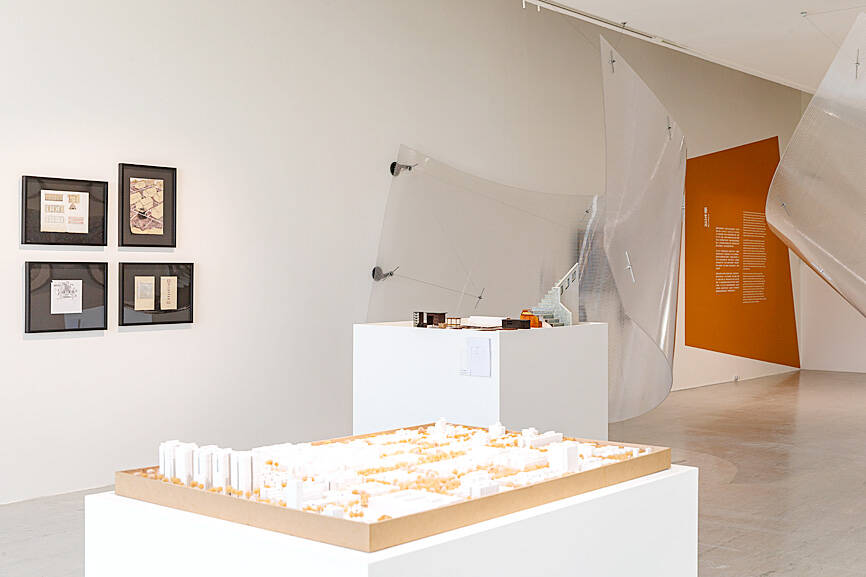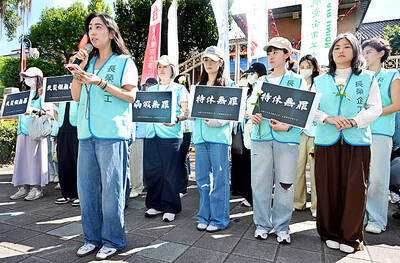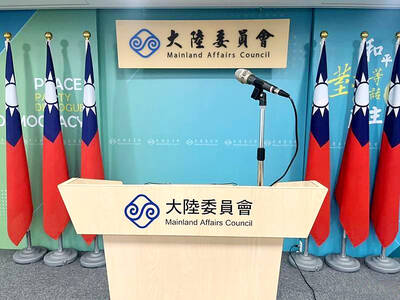A special exhibition showcasing changing architectural styles in Taiwan to reflect political, social and economic developments in the country from 1949 to 1983 opened on Saturday at Taipei Fine Arts Museum.
Titled “Modern Life, Taiwan Architecture 1949-1983,” the exhibition is intended to gauge what happened in Taiwan from just after the end of World War II to the opening of the museum, the museum said in a statement on Friday.
A model of the Chiang A-hsing Mansion built in Hsinchu County in 1949 is displayed in the first part of the exhibition to show the diverse cultures in Taiwan at the end of Japanese colonial rule.

Photo courtesy of the museum via CNA
The historic building features Western, Japanese and Taiwanese elements, said Wu Kwang-tyng (吳光庭), one of the three academics who curated the exhibition.
National Cheng Kung University’s Future Venue in Tainan (1959) and National Taiwan University’s Agricultural Exhibition Hall in Taipei (1963) were picked to highlight the introduction of US building skills and techniques when Taiwan received aid from the US from 1951 to 1965, the statement said.
The Chinese Nationalist Party (KMT) government’s efforts to introduce Chinese architectural elements in local buildings, such as the National Taiwan Craft Research and Development Institute’s Taipei Branch (1959) in Nanhai Academy, are also featured, along with local architects’ attempts to create modern Chinese-style buildings, the museum said.
The works by local architects include the Sun Yat-sen Memorial Hall (1972) designed by Wang Da-hong (王大閎), and the library of Taipei Municipal Jinmei Girls’ High School (1968) by Xiu Ze-lan (修澤蘭), Taiwan’s first female architect.
The landmark commercial complex Wan Nian Building (1973) in Taipei’s Ximending (西門町) shopping district is featured to showcase the urbanization and rise of consumerism in Taiwan, the museum said.
Works by foreign architects in Taiwan featured in the exhibition include the chapel building of St Joseph Technical Senior High School in Taitung County (1960) by Swiss architect Justus Dahinden.
The exhibition featuring building models, blueprints, documents and videos runs until June 30.

A drunk woman was sexually assaulted inside a crowded concourse of Taipei Railway Station on Thursday last week before a foreign tourist notified police, leading to calls for better education on bystander intervention and review of security infrastructure. The man, surnamed Chiu (邱), was taken into custody on charges of sexual assault, taking advantage of the woman’s condition and public indecency. Police discovered that Chiu was a fugitive with prior convictions for vehicle theft. He has been taken into custody and is to complete his unserved six-month sentence, police said. On Thursday last week, Chiu was seen wearing a white

EVA Airways, one of the leading international carriers in Taiwan, yesterday said that it was investigating reports that a cabin crew manager had ignored the condition of a sick flight attendant, who died on Saturday. The airline made the statement in response to a post circulating on social media that said that the flight attendant on an outbound flight was feeling sick and notified the cabin crew manager. Although the flight attendant grew increasingly ill on the return flight, the manager did not contact Medlink — a system that connects the aircraft to doctors on the ground for treatment advice during medical

The Taoyuan Flight Attendants’ Union yesterday vowed to protest at the EVA Air Marathon on Sunday next week should EVA Airway Corp’s management continue to ignore the union’s petition to change rules on employees’ leave of absence system, after a flight attendant reportedly died after working on a long-haul flight while ill. The case has generated public discussion over whether taking personal or sick leave should affect a worker’s performance review. Several union members yesterday protested at the Legislative Yuan, holding white flowers and placards, while shouting: “Life is priceless; requesting leave is not a crime.” “The union is scheduled to meet with

‘UNITED FRONT’ RHETORIC: China’s TAO also plans to hold weekly, instead of biweekly, news conferences because it wants to control the cross-strait discourse, an expert said China’s plan to expand its single-entry visa-on-arrival service to Taiwanese would be of limited interest to Taiwanese and is a feeble attempt by Chinese administrators to demonstrate that they are doing something, the Mainland Affairs Council said yesterday. China’s Taiwan Affairs Office (TAO) spokesman Chen Binhua (陳斌華) said the program aims to facilitate travel to China for Taiwanese compatriots, regardless of whether they are arriving via direct flights or are entering mainland China through Hong Kong, Macau or other countries, and they would be able to apply for a single-entry visa-on-arrival at all eligible entry points in China. The policy aims